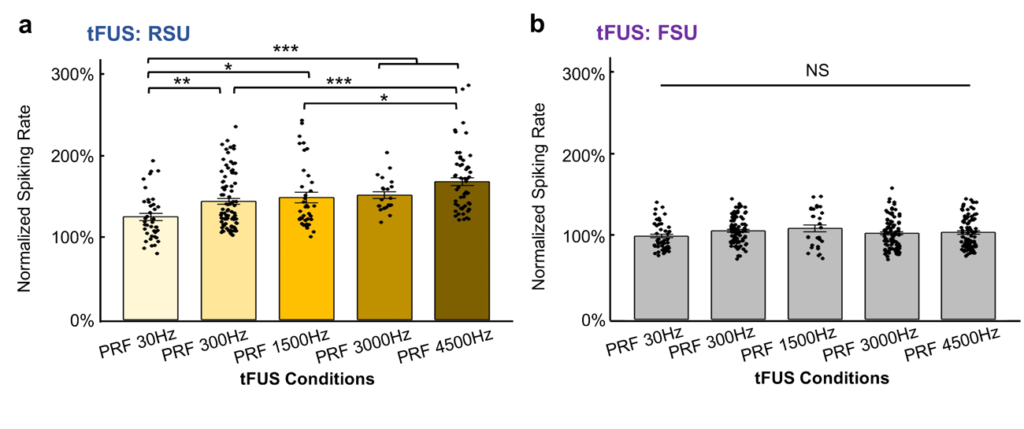Neuromodulation, a therapeutic approach used in the treatment of neurological disorders such as Parkinson’s disease, epilepsy, and insomnia, delivers controlled physical energy to the patient’s nervous system. However, currently used clinical neuromodulation techniques are either invasive, such as deep brain stimulation where electrodes must be implanted into the brain, or unfocused, such as transcranial current stimulation where electrodes are placed on the head.
Scientists now report a precise, noninvasive, and reversible neuromodulation technology that transmits low-intensity transcranial focused ultrasound (tFUS) pulses through the skull with high spatial resolution and selectivity at targeted brain regions that can be tuned to activate or deactivate neural circuits.
Using this approach, a group of scientists led by Bin He, PhD, professor at Carnegie Mellon University’s College of Engineering and the Neuroscience Institute, discovered that specific cell types can be targeted in animal models and that while excitatory neurons show high sensitivity to ultrasound pulse repetition frequency, inhibitory neurons do not.

The application of this research has broad therapeutic implications. This noninvasive neuroengineering solution can be applied to not only provide diagnostic techniques, but also innovative treatment options. For individuals suffering from pain, depression, and other diseases, tFUS neuromodulation could be used to precisely target brain circuits and activate or inhibit selected sub-populations of neurons by tuning ultrasound parameters.
The study, reported in an article in the journal Nature Communications titled, “Intrinsic functional neuron-type selectivity of transcranial focused ultrasound neuromodulation,” is funded in part by the NIH BRAIN Initiative, National Institute of Mental Health (NIMH), National Institute of Biomedical Imaging and Bioengineering (NIBIB), National Institute of Neurological Disorders and Stroke (NINDS), and National Center for Complementary and Integrative Health (NCCIH).

“As a result of our research, we obtained direct evidence that different neuron populations unequally respond to ultrasound stimulation in the brain,” said Kai Yu, PhD, co-first author of the paper and a research scientist in He’s lab at Carnegie Mellon University. “We identified a critical stimulation parameter that is able to tune the balance between excitatory and inhibitory neuronal activities, and we conducted thorough control experiments to support these valuable neuroscience findings.”
Ultrasound is commonly used to assess fetal health in expectant mothers. Would these new findings suggest that the use of ultrasound in prenatal diagnostics could affect developing neurons in the fetus? He said: “It is my understanding that diagnostic ultrasound does not use focused ultrasound, so it is hard to extrapolate learnings from our findings to apply to ultrasound applications in prenatal diagnostics. There is a difference between neuromodulation, which usually delivers a series of acoustic energy for a sustained duration, [and] diagnostic testing such as prenatal diagnostics, when ultrasound is transmitted briefly to the tissue. Also, since the transcranial focused ultrasound we use is of very low intensity, there is no evidence suggesting that use of focused ultrasound neuromodulation has safety concerns.”
It remains unclear why excitatory but not inhibitory neurons show high sensitivity to ultrasound pulse repetition. He added, “It may be due to the different structure of excitatory versus inhibitory neurons in the brain…we are still working on delineating its mechanism.”
In future studies, He also intends to increase the technology’s spatial resolution and focality, and directly test the applicability of tFUS to treat brain conditions in humans.
“If we can localize and target areas of the brain using acoustic, ultrasound energy, I believe we can potentially treat a myriad of neurological and psychiatric diseases and conditions,” said He. “This type of treatment option has great potential to shift what doctors study in medical school and go on to practice. Of course, a noninvasive, precise, reversive treatment option also presents endless benefits for patients. My dream would be to make everything noninvasive.”






